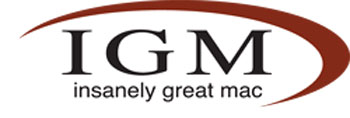The shape of Macs to come
May 22nd 2002
With the launch of Xserve, it seems a virtual certainty that the next update of Apple's Pro desktop line will ship with DDR266 RAM, though not a full implementation thereof. This memory standard has been in available in PC desktops since early 2001 and continues to be Intel's choice for mainstream desktop computers, though VIA and SiS both are now pushing DDR333 chipsets.
Apple and Motorola are for better and worse followers. No where is this more evident than in the G4's limited system bus, which is currently capped at single-data-rate (133MHz, 1GB/s) (Thanks to Chris for pointing out egregious errors in this section).
The motherboards inside updated PowerMacs will largely mirror the specifications (i.e. system bus, memory bandwidth, cache) listed for the Xserve. Again, the underlying limiting factor is the G4 processor and lack of support for faster than 133MHz technologies.
Graphics, PCI support
Mac OS Rumors (MOSR) speculates that not only will the new Pro systems get faster GeForce4-family graphics cards, Apple will also implement an 8X AGP slot. To be sure, there will be faster graphics included, however, 8X AGP isn't available yet on the PC side. Apple's apparently special relationship with nVidia could be the trump card that brings 8X AGP to the Mac, but I'd say this technology won't likely be available until MWSF in January.
Aside from a faster system bus and juicier memory, the most interesting rumor circulating about updated Pro towers is the possibility of the return of six PCI slots. If Apple is to increase its already hefty share of the media-creation market, six-slot systems are imperative. I have numerous friends still pluggin along with Jurassic 9600s and they are loathe to give them up.
MOSR speculates that Pro 2002 desktops will include three 66MHz and three 33MHz slots.
During the height of "G5 fever" in the run up to MWSF last December when the high-end was pegged at 1.6GHz and it appears that's about the maximum we can expect when new G4s are announced in July. MOSR and other sources say, however, that the most we can expect is 1.5GHz with 1.4GHz as the most likely CPU to grace the innards of Apple's revised PowerMacs.
In terms of new and/or improved L3 cache technology, we've pretty much got the best that's currently available anywhere -- this is perhaps the only area where Macs excell in comparison to their PC counterparts. But reason we've gotten this is because Macs on the whole lag the throughput provided by PCs -- it's a fix, it's a "kludge" used to make us more equal.
Updated I/O?
FireWire 2.0 (IEEE1394b) won't likely make an appearance as silicon hasn't been announced. It's possible Apple has managed to keep a lid on 1394b (800Mbs) developments, but it's highly unlikely given the number of players involved. It's probable that improved 1394a support (i.e. performance that approaches the theoretical 50MB/s maxium of the standard) will be included as TI and others are providing tweaked chips.
Outside the Mac space and Japan, where the pursuit of technology is high religion, FireWire is widely seen as foundering, so there's not a lot of pressure to push out the next version of the technology. Last year's pricing and licensing issues have been resolved, but now Intel has come out against the technology. Moreover, whereas USB 2.0 implementations don't require vendors to pay royalties, FireWire does.
On the PC side, USB 2.0 is gathering momentum. Intel product manager Grace Wang told me that she expects one-third of all new PCs shipped by the end of 2003 will include it. The caveat here, however, is that there are very few devices available that implement USB 2.0 -- chicken and the egg. Also, some of the implementation problems that plagued USB 1.0 also appear to be bedeviling v2.0 -- including buggy devices and slow real-world throughput (13+MB/s as opposed to the advertised maximum of 60MB/s).
Moreover, although FireWire hasn't really caught on in terms of the broader market, it has taken firm root in the DV space. Ms. Wang's assertion that USB 2.0 "is for video" doesn't jibe well with the reality that FireWire owns this space and that there isn't any consumer groundswell for USB 2.0-powered video devices -- it's just too esoteric for the average user.
The bottom line? Apple's new PowerMacs won't likely include USB 2.0 -- there just aren't enough devices to warrant it's inclusion.
Networking
PowerMacs already include Gigabit Ethernet, so it's unlikely that we'll see any change here. It is, of course, possible that Apple will "upgrade" on-board Gigabit Ethernet from the anaemic 350Mbs speeds now common.
It's widely rumored that Apple will add Bluetooth networking to its Pro desktop line. Specifics aren't known, but we reported, quoting MacUser UK, earlier this week that experts are unconcerned with Apple's cancellation of Bluetooth adaptor orders because of the company's plans to integrate the networking technology into upcoming desktops. How this will pan out is anyone's guess.
Wrap up
We will be seeing faster memory (DDR266) and CPUs, but clock speeds will likely still be under 1.5GHz. The high-end will still be a dual processor G4, even if Apple does call it a "G5." 8X AGP is an intriguing possibility and would do much to dispell the impression that Macs lag behind in graphics technology, but to me it doesn't seem likely given the relative immaturity of the standard and lack of hardware.
Also, the advent of DDR266 a generational shift for the Mac and Apple will likely emphasize this with new enclosures. It would be wise if Apple concurrently included noise, power and heat-reduction technologies as these issues are of increasing importance to users and administrators.
